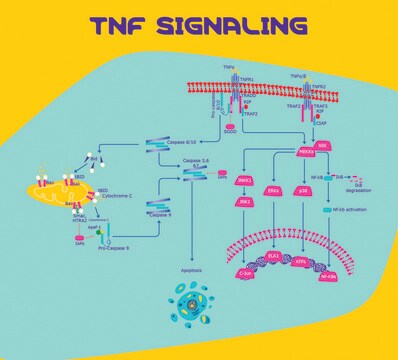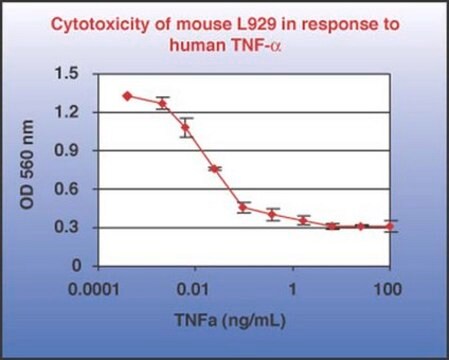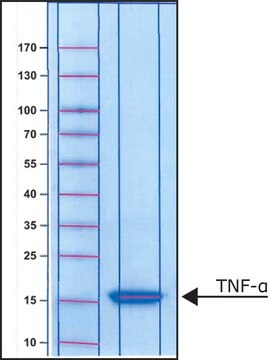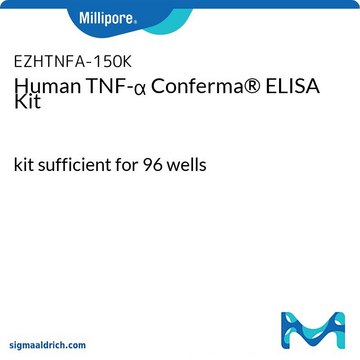11088939001
Roche
Tumor Necrosis Factor-α, human (hTNF-α)
recombinant (yeast)
Sinonimo/i:
hTNF, human necrosis factor
Autenticatiper visualizzare i prezzi riservati alla tua organizzazione & contrattuali
About This Item
Codice UNSPSC:
12352207
Prodotti consigliati
Origine biologica
human
Livello qualitativo
Ricombinante
expressed in yeast
Saggio
≥95% (SDS-PAGE)
Stato
solution
Potenza
≤0.01 ng/mL EC50
Attività specifica
>1*10^8 U/mg
PM
17,000 Da
Confezionamento
pkg of 1,000,000 U (10 μg, 1ml)
Produttore/marchio commerciale
Roche
Condizioni di stoccaggio
avoid repeated freeze/thaw cycles
Impurezze
<0.1 EU/μgtested (LAL test)
N° accesso UniProt
Temperatura di conservazione
−20°C
Informazioni sul gene
human ... TNF(7124)
Descrizione generale
>1 x 10⊥8 U/mg, <0.01 ng/ml (hTNF-a, NIBSC, interim standard, 87/650), at least the same specific activity (EC50) compared to the indicated standard is guaranteed.
Specificità
Human hTNF-α is effective on human and mouse cells.
Species specificity: human, mouse
Applicazioni
Tumor Necrosis Factor-α (hTNF-α)
- Shows cytolytic and/or cytostatic activity on a variety of transformed cell lines.
- Has activating and growth stimulating activities on a variety of normal cells.
- Has antiviral activity on many cell types in vitro.
- Can cause tumor necrosis of certain tumors in vivo.
Azioni biochim/fisiol
Receptor p55 and p75, belonging to the TNFR gene family, mediate the biological activity of TNF-a, and are co-expressed on the surface of various cell types. The pleiotropic action of TNF-a is initiated by binding to either of the two receptors.
Qualità
Purity: >95% (SDS-PAGE)
Endotoxin level: <0.1 EU/μg (LAL-test), <10 EU/ml (LAL-test)
Endotoxin level: <0.1 EU/μg (LAL-test), <10 EU/ml (LAL-test)
Sequenza
Chain Length 157 AA
One polypeptide chain (157 amino acids), identical to natural hTNF-α.
Definizione di unità
EC50 definition: The amount of hTNF-α that is required to mediate half-maximal cytotoxicity (MTT cleavage) with WEHI 164 cells in the presence of actinomycin D (1 unit equals ≤0.01 ng/ml).
Stato fisico
Solution, filtered through 0.2 μm pore size membrane.
Nota sulla preparazione
Working concentration: 1 ng/ml
For complete cell lysis of sensitive cell lines about 1 ng/ml is recommended.
Working solution: Dilute the concentrated hTNF-α solution (10 μg/ml) with PBS or culture medium containing BSA (or HSA), 1 mg/ml (0.1%) or serum 1 to 10%.
Storage conditions (working solution): -15 to -25 °C
It is recommended to store the solution in aliquots at -15 to -25 °C.
Note: Avoid repeated freezing and thawing.
For complete cell lysis of sensitive cell lines about 1 ng/ml is recommended.
Working solution: Dilute the concentrated hTNF-α solution (10 μg/ml) with PBS or culture medium containing BSA (or HSA), 1 mg/ml (0.1%) or serum 1 to 10%.
Storage conditions (working solution): -15 to -25 °C
It is recommended to store the solution in aliquots at -15 to -25 °C.
Note: Avoid repeated freezing and thawing.
Altre note
For life science research only. Not for use in diagnostic procedures. 1 EU corresponds to 0.1 ng
Codice della classe di stoccaggio
12 - Non Combustible Liquids
Classe di pericolosità dell'acqua (WGK)
nwg
Punto d’infiammabilità (°F)
does not flash
Punto d’infiammabilità (°C)
does not flash
Scegli una delle versioni più recenti:
Possiedi già questo prodotto?
I documenti relativi ai prodotti acquistati recentemente sono disponibili nell’Archivio dei documenti.
P De Cesaris et al.
The Journal of biological chemistry, 274(41), 28978-28982 (1999-10-03)
Tumor necrosis factor alpha (TNF-alpha) is a cytokine implicated in the pathogenesis of numerous chronic and acute inflammatory conditions. We have previously shown that mouse Sertoli cells respond to TNF-alpha by increasing interleukin-6 production and intercellular adhesion molecule-1 (ICAM-1) expression
Rajitha Indukuri et al.
Frontiers in endocrinology, 12, 650625-650625 (2021-04-17)
Inflammation is a primary component of both initiation and promotion of colorectal cancer (CRC). Cytokines secreted by macrophages, including tumor necrosis factor alpha (TNFα), activates the pro-survival transcription factor complex NFκB. The precise mechanism of NFκB in CRC is not
Il team dei nostri ricercatori vanta grande esperienza in tutte le aree della ricerca quali Life Science, scienza dei materiali, sintesi chimica, cromatografia, discipline analitiche, ecc..
Contatta l'Assistenza Tecnica.







